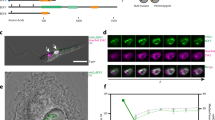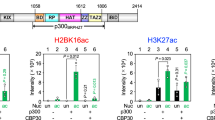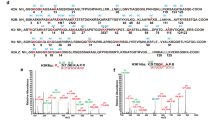Abstract
The Polybromo (PB) protein functions as a key component of the human PBAF chromatin remodeling complex in regulation of gene transcription. PB is made up of modular domains including six bromodomains that are known as acetyl-lysine binding domains. However, histone-binding specificity of the bromodomains of PB has remained elusive. In this study, we report biochemical characterization of all six PB bromodomains' binding to a suite of lysine-acetylated peptides derived from known acetylation sites on human core histones. We demonstrate that bromodomain 2 of PB preferentially recognizes acetylated lysine 14 of histone H3 (H3K14ac), a post-translational mark known for gene transcriptional activation. We further describe the molecular basis of the selective H3K14ac recognition of bromodomain 2 by solving the protein structures in both the free and bound forms using X-ray crystallography and NMR, respectively.
Similar content being viewed by others
Log in or create a free account to read this content
Gain free access to this article, as well as selected content from this journal and more on nature.com
or
Accession codes
References
Seet BT, Dikic I, Zhou MM, Pawson T . Reading protein modifications with interaction domains. Nat Rev Mol Cell Biol 2006; 7:473–483.
Taverna SD, Li H, Ruthenburg AJ, Allis CD, Patel DJ . How chromatin-binding modules interpret histone modifications: lessons from professional pocket pickers. Nat Struct Mol Biol 2007; 14:1025–1040.
Sanchez R, Zhou MM . The role of human bromodomains in chromatin biology and gene transcription. Curr Opin Drug Discov Devel 2009; 12:659–665.
Awad S, Hassan AH . The Swi2/Snf2 bromodomain is important for the full binding and remodeling activity of the SWI/SNF complex on H3- and H4-acetylated nucleosomes. Ann NY Acad Sci 2008; 1138:366–375.
Zeng L, Zhou M . Bromodomain: an acetyl-lysine binding domain. FEBS Lett 2002; 513:124–128.
Hassan AH, Prochasson P, Neely KE, et al. Function and selectivity of bromodomains in anchoring chromatin-modifying complexes to promoter nucleosomes. Cell 2002; 111:369–379.
Chandy M, Gutierrez J, Prochasson P, Workman J . SWI/SNF displaces SAGA-acetylated nucleosomes. Eukaryot Cell 2006; 5:1738–1747.
Wang Z, Zhai W, Richardson J, et al. Polybromo protein BAF180 functions in mammalian cardiac chamber maturation. Genes Dev 2004; 18:3106–3116.
Huang X, Gao X, Diaz-Trelles R, Ruiz-Lozano P, Wang Z . Coronary development is regulated by ATP-dependent SWI/SNF chromatin remodeling component BAF180. Dev Biol 2008; 319:258–266.
Trotter KW, Archer TK . Reconstitution of glucocorticoid receptor-dependent transcription in vivo. Mol Cell Biol 2004; 24:3347–3358.
Xia W, Nagase S, Montia AG, et al. BAF180 is a critical regulator of p21 induction and a tumor suppressor mutated in breast cancer. Cancer Res 2008; 68:1667–1674.
Nicolas RH, Goodwin GH . Molecular cloning of polybromo, a nuclear protein containing multiple domains including five bromodomains, a truncated HMG-box, and two repeats of a novel domain. Gene 1996; 175:233–240.
Thompson M . Polybromo-1: the chromatin targeting subunit of the PBAF complex. Biochimie 2009; 91:309–319.
Goodwin G, Nicolas R . The BAH domain, polybromo and the RSC chromatin remodelling complex. Gene 2001; 268:1–7.
Mujtaba S, He Y, Zeng L, et al. Structural basis of lysine-acetylated HIV-1 Tat recognition by PCAF bromodomain. Mol Cell 2002; 9:575–586.
Mujtaba S, He Y, Zeng L, et al. Structural mechanism of the bromodomain of the coactivator CBP in p53 transcriptional activation. Mol Cell 2004; 13:251–263.
Shen W, Xu C, Huang W, et al. Solution structure of human Brg1 bromodomain and its specific binding to acetylated histone tails. Biochemistry 2007; 46:2100–2110.
Zeng L, Zhang Q, Gerona-Navarro G, Moshkina N, Zhou M-M . Structural basis of site-specific histone recognition by the bromodomains of human coactivators PCAF and CBP/p300. Structure 2008; 16:643–652.
Chandrasekaran R, Thompson M . Polybromo-1-bromodomains bind histone H3 at specific acetyl-lysine positions. Biochem Biophys Res Commun 2007; 355:661–666.
Thompson M, Chandrasekaran R . Thermodynamic analysis of acetylation-dependent Pb1 bromodomain-histone H3 interactions. Anal Biochem 2008; 374:304–312.
Bernstein E, Duncan E, Masui O, et al. Mouse polycomb proteins bind differentially to methylated histone H3 and RNA and are enriched in facultative heterochromatin. Mol Cell Biol 2006; 26:2560–2569.
Li H, Ilin S, Wang W, et al. Molecular basis for site-specific read-out of histone H3K4me3 by the BPTF PHD finger of NURF. Nature 2006; 442:91–95.
Long F, Vagin AA, Young P, Murshudov GN . BALBES: a molecular-replacement pipeline. Available at: http://journals.iucr.org/d/issues/2008/01/00/ba5114/ba5114hdr.html.
Adams PD, Grosse-Kunstleve RW, Hung LW, et al. PHENIX: building new software for automated crystallographic structure determination. Acta Crystallogr D Biol Crystallogr 2002; 58 (Pt 11):1948–1954.
Dhalluin C, Carlson J, Zeng L, et al. Structure and ligand of a histone acetyltransferase bromodomain. Nature 1999; 399:491–496.
Shen W, Xu C, Huang W, et al. Solution structure of human Brg1 bromodomain and its specific binding to acetylated histone tails. Biochemistry 2007; 46:2100–2110.
Liu Y, Wang X, Zhang J, et al. Structural basis and binding properties of the second bromodomain of Brd4 with acetylated histone tails. Biochemistry 2008; 47:6403–6417.
Dey A, Nishiyama A, Karpova T, McNally J, Ozato K . Brd4 marks select genes on mitotic chromatin and directs postmitotic transcription. Mol Biol Cell 2009; 20:4899–4909.
Lin YJ, Umehara T, Inoue M, et al. Solution structure of the extraterminal domain of the bromodomain-containing protein BRD4. Protein Sci 2008; 17:2174–2179.
Nagashima T, Maruyama T, Furuya M, et al. Histone acetylation and subcellular localization of chromosomal protein BRD4 during mouse oocyte meiosis and mitosis. Mol Hum Reprod 2007; 13:141–148.
Hargreaves DC, Horng T, Medzhitov R . Control of inducible gene expression by signal-dependent transcriptional elongation. Cell 2009; 138:129–145.
Leschziner AE, Lemon B, Tjian R, Nogales E . Structural studies of the human PBAF chromatin-remodeling complex. Structure 2005; 13:267–275.
Carey M, Li B, Workman J . RSC exploits histone acetylation to abrogate the nucleosomal block to RNA polymerase II elongation. Mol Cell 2006; 24:481–487.
Kasten M, Szerlong H, Erdjument-Bromage H, et al. Tandem bromodomains in the chromatin remodeler RSC recognize acetylated histone H3 Lys14. EMBO J 2004; 23:1348–1359.
Vandemark AP, Kasten MM, Ferris E, et al. Autoregulation of the rsc4 tandem bromodomain by gcn5 acetylation. Mol Cell 2007; 27:817–828.
Hassan A, Neely K, Workman J . Histone acetyltransferase complexes stabilize swi/snf binding to promoter nucleosomes. Cell 2001; 104:817–827.
Hassan A, Awad S, Prochasson P . The Swi2/Snf2 bromodomain is required for the displacement of SAGA and the octamer transfer of SAGA-acetylated nucleosomes. J Biol Chem 2006; 281:18126–18134.
Moriniere J, Rousseaux S, Steuerwald U, et al. Cooperative binding of two acetylation marks on a histone tail by a single bromodomain. Nature 2009; 461:664–668.
Vaynberg J, Fukuda T, Chen K, et al. Structure of an ultraweak protein-protein complex and its crucial role in regulation of cell morphology and motility. Mol Cell 2005; 17:513–523.
Leschziner A, Saha A, Wittmeyer J, et al. Conformational flexibility in the chromatin remodeler RSC observed by electron microscopy and the orthogonal tilt reconstruction method. Proc Natl Acad Sci USA 2007; 104:4913–4918.
Kim S, Sprung R, Chen Y, et al. Substrate and functional diversity of lysine acetylation revealed by a proteomics survey. Mol Cell 2006; 23:607–618.
Choudhary C, Kumar C, Gnad F, et al. Lysine acetylation targets protein complexes and co-regulates major cellular functions. Science 2009; 325:834–840.
Letunic I, Doerks T, Bork P . SMART 6: recent updates and new developments. Nucleic Acids Res 2009; 37 (Database issue):D229–D232.
Pavlidis P, Noble W . Matrix2png: a utility for visualizing matrix data. Bioinformatics 2003; 19:295–296.
Clore GM, Gronenborn AM . Multidimensional heteronuclear nuclear magnetic resonance of proteins. Methods Enzymol 1994; 239:349–363.
Shen S, Sandoval J, Swiss VA, et al. Age-dependent epigenetic control of differentiation inhibitors is critical for remyelination efficiency. Nat Neurosci 2008; 11:1024–1034.
Delaglio F, Grzesiek S, Vuister GW, et al. NMRPipe: a multidimensional spectral processing system based on UNIX pipes. J Biomol NMR 1995; 6:277–293.
Johnson BA . Using NMRView to visualize and analyze the NMR spectra of macromolecules. Methods Mol Biol 2004; 278:313–352.
Brunger AT, Adams PD, Clore GM, et al. Crystallography & NMR system: a new software suite for macromolecular structure determination. Acta Crystallogr D Biol Crystallogr 1998; 54 (Pt 5):905–921.
Rieping W, Habeck M, Bardiaux B, et al. ARIA2: automated NOE assignment and data integration in NMR structure calculation. Bioinformatics 2007; 23:381–382.
Laskowski RA, Rullmann JAC, MacArthur MW, Kaptein R, Thornton JM . AQUA and PROCHECK-NMR: Programs for checking the quality of protein structures solved by NMR. J Biomol NMR 1996; 8:477–486.
Acknowledgements
We wish to acknowledge the use of the NMR facility at the New York Structural Biology Center and the staff at the X6A beamline of the National Synchrotron Light Sources at the Brookhaven National Laboratory for facilitating X-ray data collection. We thank D Lencer and W Shreffler (Mount Sinai School of Medicine) for discussion of peptide microarray, S Chakravarty (Mount Sinai School of Medicine) for discussion on structure-based sequence alignment, and A Plotnikov (Mount Sinai School of Medicine), R Page (Brown University) and V Stojanoff (the Brookhaven National Laboratory) for protein structural analysis using X-ray crystallography techniques. This work was supported by a graduate training program fellowship from the National Cancer Institute (ZC-P) and research grants from the National Institutes of Health (M-MZ). ZC-P dedicates this study in the loving memory of Meg Charlop.
Author information
Authors and Affiliations
Corresponding author
Rights and permissions
About this article
Cite this article
Charlop-Powers, Z., Zeng, L., Zhang, Q. et al. Structural insights into selective histone H3 recognition by the human Polybromo bromodomain 2. Cell Res 20, 529–538 (2010). https://doi.org/10.1038/cr.2010.43
Received:
Revised:
Accepted:
Published:
Issue date:
DOI: https://doi.org/10.1038/cr.2010.43
Keywords
This article is cited by
-
Exploiting vulnerabilities of SWI/SNF chromatin remodelling complexes for cancer therapy
Oncogene (2021)
-
Structure of SWI/SNF chromatin remodeller RSC bound to a nucleosome
Nature (2020)
-
PBRM1 acts as a p53 lysine-acetylation reader to suppress renal tumor growth
Nature Communications (2019)
-
DNA binding drives the association of BRG1/hBRM bromodomains with nucleosomes
Nature Communications (2017)
-
Readers of histone modifications
Cell Research (2011)



